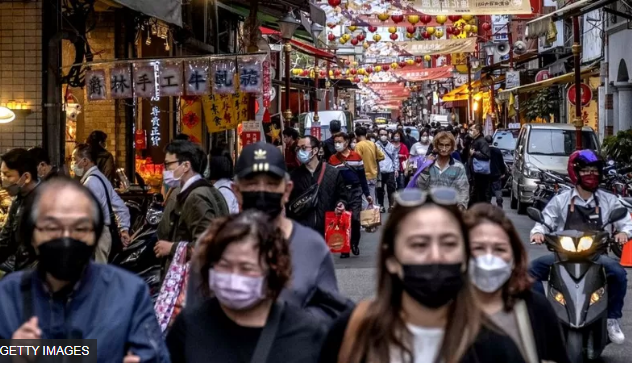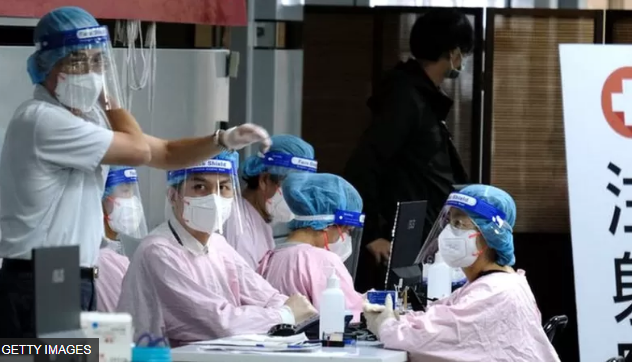Epidemic in Taiwan: The number of confirmed diagnoses remains high, experts say that a quick solution and a prolonged epidemic have their own advantages and disadvantages and need to be fully prepared

The number of confirmed local cases of the new crown in Taiwan has surged recently. The number of confirmed cases in a single day has exceeded 40,000 for three consecutive days, and the total number of confirmed cases of the new crown has reached 310,000. Experts predict that the number of confirmed cases in a single day will continue to rise. And this wave of epidemics caused by the new coronavirus variant Omicron is testing Taiwan's ability to prevent epidemics.
In major hospitals in northern Taiwan, people who want to do PCR tests flock to emergency rooms, increasing the medical burden. Outside the pharmacy, there were long queues of people buying the Covid-19 quick screening boxes, and there were even chaotic scenes, causing many public grievances. Medical staff in the emergency rooms of major hospitals, overwhelmed, sick or infected, have been "calling for help" on social media and criticizing the lack of local and central government support.
Analyzing the epidemic, Wang Zhihong, a professor of pediatrics and health policy at Stanford University in the United States, emphasized to the BBC Chinese that the key now is that Taiwan needs to quickly make accurate medical resource models to face the mutant virus.
Wang Zhihong explained that the so-called simulated medical resources include the actuarial calculation of the number of emergency beds, respirators, and medicines in Taiwan's hospitals every day. The hospital must feed back the data to the local government every day, and the local government will then feed it back to the central government. This process is very difficult. Complicated, but important. "Singapore has done a good job of simulation before patients are triaged."
Professor Lu Chunqi, dean of the School of Public Health at the University of California, Berkeley, analyzed that since 2022, about half of Taiwan's new crown deaths have come from patients who have not been vaccinated against Covid-19. Therefore, "the sooner Taiwan achieves universal vaccination, especially the fastest Vaccinations and boosters for vulnerable people, the fewer hospitalisations and deaths," he told the BBC.
According to the data from the Ministry of Health and Welfare of Taiwan as of the end of April this year, the proportion of people with mild disease in Taiwan currently accounts for about 99.75%.
emergency room crisis
Chen Shizhong, commander of Taiwan's Central Epidemic Command Center (CDC), estimated that the peak time of confirmed cases may occur on May 20 after the Poo Mikron variant of the virus entered the entire Taiwanese community. Some analysts also said that the current epidemic variables are still there, so it is difficult to predict the peak time.
In the face of the surge in the number of confirmed cases of the new crown in Taiwan, Taiwan's current approach is not like Shanghai's strict closure of the city, nor is it like Hong Kong's ban on indoor dining at night, closing gyms, bars and other public places.

At present, Taiwanese people go out as usual, but many elementary schools and kindergartens have announced the suspension of classes.
However, the surge in the number of confirmed cases has also created scenes of chaos, especially in the emergency rooms of major hospitals in northern Taiwan.
According to Taiwan media reports, most of the people who crowded the emergency rooms of large hospitals are not severe or even have no symptoms, but they flock to the emergency room because of anxiety. The reason is that Taiwan still needs to be confirmed by PCR testing before it can be officially regarded as a confirmed diagnosis. This also caused a large number of people to flock to the hospital for PCR testing. Among them are many people who have purchased new crown medical insurance, because they need to have a PCR test to confirm the diagnosis before they can claim.
The chaotic emergency rooms and hospitals are full, crowding out other emergency patients who really need to seek treatment, and medical staff are overwhelmed and fall ill. In addition, there are still cases where Taiwan's rapid screening reagents are still unavailable, resulting in widespread public grievances.
Accordingly, Taipei Mayor Ko Wenzhe apologized for deleting the NT$2.8 billion budget for rapid screening reagents last year. The Taiwanese government has also urgently cooperated with hundreds of community hospitals or clinics across Taiwan to allow people to go for PCR tests.

Quick screening ≠ PCR detection
In her 30s, Miss Koo (a pseudonym upon request), who has worked in Taipei for many years, told BBC Chinese that she had mild symptoms after being diagnosed by quick screening at the end of April, but was "tired" by the complicated and contradictory procedures. She said that because she was diagnosed first after traveling with her counterpart, after she was informed, she was diagnosed after quick screening because of mild symptoms. She originally wanted to isolate herself at home, but at that time, the Taiwan government stipulated that she must also go to the PCR line for testing.
She criticized that this is not to let people who go to PCR tests "go out and spread the virus". Miss Koo's doubts are one of the most important debates in Taiwan facing the Omikron epidemic.
Taipei Mayor Ko Wenzhe criticized the central government for asking people to pass a PCR test to be diagnosed, which is unwise and a waste of medical resources.
Chen Jianren, former vice president of Taiwan and current academician of the Taichung Academy of Sciences, explained that any screening test has its sensitivity, specificity, false positive rate and false negative rate. According to epidemiological studies, "the prevalence of the disease determines the positive predictive value."
Chen Jianren, who is also an epidemiologist himself, said that according to years of research and statistics in various countries, the so-called "positive predictive value" will vary significantly with the prevalence of the epidemic. For example, when the prevalence rate is 50%, it can be as high as 95%; At a prevalence of 10%, the positive predictive value was 68%. "At a prevalence of 1%, the positive predictive value is only 16%, in other words, only one of the six people who screen positive is actually sick."
Therefore, Chen Jianren believes that if home quarantine is opened, the prevalence of home quarantine objects is higher than that of the general population, so quick screening positives can be used to replace PCR diagnosis, but it is not suitable for other groups with lower prevalence rates. He called for the use of rapid screening for diagnosis in ethnic groups, regions and time periods with high prevalence rates.
Are central and local epidemic prevention out of sync?
Faced with the rapidly rising number of confirmed and critically ill patients, Taiwanese President Tsai Ing-wen said last Friday (May 6) that Taiwan expects to obtain about 100 million doses of rapid screening reagents, and "the supply will become more and more stable." She also asked local governments across Taiwan to set up community screening stations, expand PCR testing power to local areas, and plan to cooperate with grassroots clinics. The Taiwanese government also announced last week that if people are positive after rapid screening tests and confirmed by medical units, they can be regarded as confirmed cases. The new regulations will be implemented from May 12.
Tsai Ing-wen called for the cooperation between the local government and the central government to show that Taiwan's epidemic prevention model is changing in the fight against the mutant virus.
Wang Zhihong stressed that what Taiwan should do now is to fight guerrilla warfare. He told the BBC that after Omicron has spread in the Taiwanese community, epidemic prevention is no longer under the unified control of the Taiwanese central government in the past. He believes that, based on the experience of epidemic prevention in the United States, to simulate the disease and resources, the Taiwan command center needs feedback from hospitals in various places. The process is that the hospital goes to the local government, and the local government reports to the command center, but there is often a gap in numbers or time, and sometimes it is slower. In addition, there are also issues such as how local and central governments define "lack or sufficiency" of medical resources, all of which are challenges brought by Omicron.